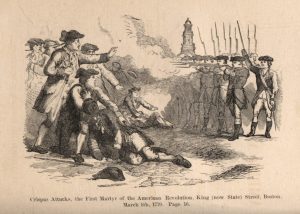 British soldiers kill five members of a Boston street mob.
British soldiers kill five members of a Boston street mob.
1770, Harassed British soldiers fire into a Boston street mob, killing five, March 5. “Boston Massacre” dead include Crispus Attucks, described as a sailor in his 40s born in Framingham to a Natick Indian mother and a black slave father. He is also usually described as a free man, although some sources claim him to be an escaped slave.
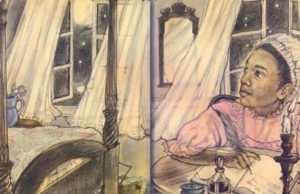 Phillis Wheatley.
Phillis Wheatley.
1770, “On the Death of the Rev. Mr. George Whitefield” is published in newspapers in Boston, New Haven and Hartford, bringing first fame to its author, Phillis Wheatley, a 17-year-old house slave to the family of Boston merchant John Wheatley. She was brought to Boston at age 8 aboard a slaver named Phillis. Wheatley’s wife and older children taught her English, introduced her to many books and encouraged her writing.
In 1773, a book of her poems is published in London, the first book published anywhere by an African-American. Statesmen and writers from Washington to King George III to Voltaire praise her work. The Wheatleys free her shortly afterward. She continues to write, but finds no support in Boston for books. She marries a free black grocer who is imprisoned for debt in 1784. She dies in relative obscurity, in December of the same year. Their infant son dies soon thereafter.
1770, Quaker Anthony Benezet founds the Negro School in Philadelphia. Three more schools for blacks open in the city before the Revolution breaks out.
1770, Georgia establishes nightly “Savannah Watch” slave patrol.
1770, Major earthquake (estimated at MI 7.5) destroys Port-au-Prince and liquifies much of the large Cul-de-Sac plain to the east, June 3. A tsunami also floods much of the plain. Many cane fields and sugar mills are destroyed, particularly in the south. Although a warning roar keeps initial deaths down to 250, more than 15,000 slaves die in the famine that follows. Another 10,000, again mostly slaves, succumb to anthrax from eating tainted meat brought in to feed them.
Sugar shortage: As Saint-Domingue was producing 40% of Europe’s sugar and 60% of its coffee, earthquake damage pushes prices up. Recovery takes years.
Prelude to revolution: Thousands of surviving slaves are able to escape disrupted plantations to marron communities in hills, several of which date back to a 1751 earthquake. They will be the vanguard of the 1790 uprising that leads to independence.
Tectonics: The North American plate pushes on the Caribbean plate along the Enriquillo and Septentrional fault zones, generating many significant earthquakes on Hispaniola. The Port-au-Prince quake of Jan. 12, 2010 kills as many as 300,000 people.
1771, Total of 29,250 slaves transported in 107 Liverpool ships, usually following Triangular Trade routes to Africa and the Americas; 8,136 in 58 London ships; 8,810 in 23 Bristol ships, indicating wide range of ship capacities.
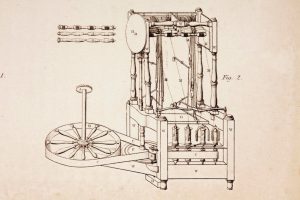 Richard Arkwright's cotton mill.
Richard Arkwright's cotton mill.
1771, Richard Arkwright, inventor of water frame, opens water-driven cotton mill on River Derwent in Cromford. This is among first factories built to house machinery rather than just gangs of workers, among first to employ and directly manage workers (rather than contract them) and among first to run by a clock. When Arkwright installs his carding machine as first step in preparing cotton fibre, it is the first factory to move from raw material to finished product in a continuous series of operations.
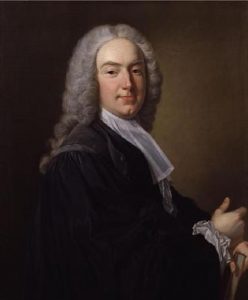 Lord Mansfield.
Lord Mansfield.
1772, In Somerset vs. Stewart, Lord Mansfield, England’s chief justice, rules that slavery has no legal protection except where common law or legislative statute explicitly sanctions it... yes in Virginia, no in England; Somerset is free. Granville Sharp argues for Somerset. Decision distresses many American slave masters, spurring talk of independence.
While Britain has no institutional slavery at least since the 12th century, purchased slaves have been brought in to be servants over many years. More than 10,000 of these are suddenly considered freed by the Somerset ruling.
The ruling serves to contrast a no-slavery Britain with its colonies built around large slave populations.
1772, John Woolman, the Quaker preacher who has convinced many fellow Friends to free their slaves, and many Friends Meetings in the 13 colonies to oppose slavery, journeys to England to persuade England’s Friends to call for abolition in their annual Epistle. He dies of smallpox in York, October, age 51.
The Journal of John Woolman is published in 1774 by a Quaker printer in Philadelphia. In it, Woolman vividly describes how his personal experience with slavery led to his outspoken opposition.
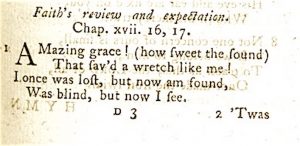 'Amazing Grace' excerpt.
'Amazing Grace' excerpt.
1772, John Newton, ex slave-ship captain, writes “Amazing Grace” for New Year’s Day (1773) service at the church of St. Peter and St. Paul in Olney, England, where he is a curate.
1773, Benjamin Rush, prominent Philadelphia doctor and community leader, publishes, "An Address to the Inhabitants of the British Settlements in America, upon Slave-Keeping" attacking slave trade and slavery in general. Three years later, he signs Declaration of Independence.
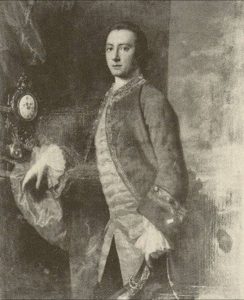 Peter Manigault.
Peter Manigault.
1773, Peter Manigault, a prominent South Carolina plantation and slave master, attorney and legislator, dies as the wealthiest man in British North America, Nov. 12. His surviving father, Gabriel, is a separately wealthy plantation and slaveholder who will support the American side in the Revolution.
Peter’s wife, Elizabeth, who dies earlier the same year, is the daughter of Joseph Wragg, a leading slave trader of the early 18th century.
1773-1775, More than 20,000 die on Cape Verde Islands after several years of drought. The islands suffer periodically from lack of rain, and resulting famine and disease.
 Lord Dunmore's militia fight Shawnee and Mingo people.
Lord Dunmore's militia fight Shawnee and Mingo people.
1774, Lord Dunmore, royal governor of Virginia, leads militia against Shawnee and Mingo people opposed to white settlers moving into their hunting lands south of the Ohio river (present-day West Virginia and Kentucky).
More militia than Indians die in Point Pleasant battle, Oct. 10, but the latter retreat across the river, and eventually are forced to cede their lands to Virginia.
The following year, Daniel Boone helps widen a path through the Cumberland Gap, which becomes part of the Wilderness Road, the main throughfare between Virginia and Kentucky.
As the Revolutionary War breaks out, Shawnee and Cherokee side with British and Loyalists against the American settlers.
1774, English Society of Friends votes to expel any member engaged in the slave trade.
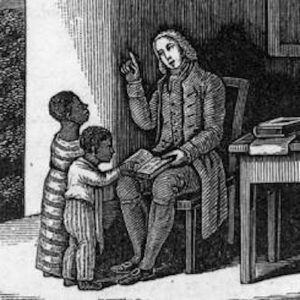 Anthony Benezet educates young Negros.
Anthony Benezet educates young Negros.
1775, Society for Relief of Free Negroes Unlawfully Held in Bondage established in Philadelphia by Quaker Anthony Benezet; Thomas Paine is a supporter, April 14. This first abolitionist group in America becomes the Pennsylvania Abolition Society after the Revolution with Benjamin Franklin as president.
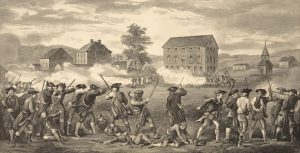 Battle at Lexington and Concord.
Battle at Lexington and Concord.
1775, American Revolution breaks out with skirmishes at Lexington and Concord, April 19. British attack is decimated at Bunker Hill, June 17. George Washington, commissioned by Continental Congress in Philadelphia, takes command of patriot forces surrounding Boston, July 3.
1775, Thomas Jeremiah, a free and prosperous black harbor pilot, is hanged in Charles Town on suspicion that he plans to aid a possible British attack, Aug. 18. An attack comes, but 10 months later.
 Lord Dunmore.
Lord Dunmore.
1775, In Virginia, Lord Dunmore proclaims martial law and offers freedom to all ”indentured servants, Negroes or others” willing to desert rebelling masters to fight for the crown, Nov. 7. Furious members of Virginia Convention respond by promising death “without benefit of clergy” to any slave acting on Dunmore’s offer.
Between 800 and 2,000 slaves—of both Patriot and Loyalist masters—enlist with Dunmore. This Ethiopian Regiment fights one battle north of Norfolk, a British loss, before being riddled by smallpox. After much of Norfolk burns down in another fight with rebels, Dunmore is forced to depart by ship for New York, taking 300 ex-slaves with him.
1775, Slavery abolished on Madeira, where Portuguese first developed the slave-plantation model in the 15th century. For some time, tenant farmers have done most of the work, long diversified from sugar.
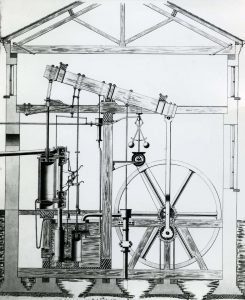 James Watt's steam engine.
James Watt's steam engine.
1775, In England, James Watt patents an improved steam engine, which first powers mine pumps but is soon applied to factories, including cotton mills.
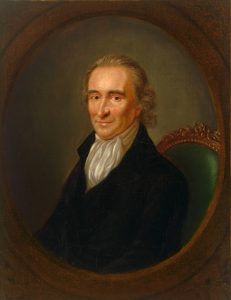 Thomas Paine.
Thomas Paine.
1776, Thomas Paine lays out the case for American Independence in Common Sense, January; 100,000 copies distributed in a few months. Title is suggested by mentor Benjamin
Rush, soon to sign the Declaration of Independence.
Patriots drag heavy guns from Fort Ticonderoga to Dorchester Heights overlooking British forces in Boston. The latter evacuate the city, March 17, never to return.
1776, British attempt with 20 ships and 2,900 men to take Charles Town, SC. But fleet is turned back by stubborn American fire from Fort Sullivan, June 28.
British sought to use port to link up with Loyalists. Their defeat helps convince South Carolina delegation at Continental Congress to support Declaration of Independence.
Meanwhile, a much larger British fleet enters New York Harbor and lands thousands of troops on Staten Island. They prepare for major attack on Brooklyn and New York.
1776, “A Dialogue Concerning the Slavery of the Africans” is delivered to the Continental Congress in Philadelphia to urge not only an end to the slave trade, but the emancipation of all slaves. The author is Samuel Hopkins, the Newport Congregational minister who led efforts to ban the slave trade in Rhode Island and Connecticut.
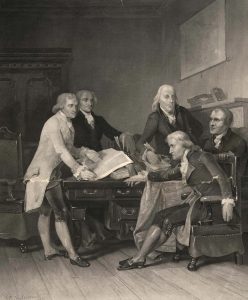 The signing of the Declaration of Independence.
The signing of the Declaration of Independence.
1776, Declaration of Independence signed and issued in Philadelphia, July 4; declares “all men are created equal” in the words of Thomas Jefferson, a Virginia master of hundreds of slaves. His clause to ban the slave trade is deleted, however.
Declaring independence are “the United States of America.”
1776, The Societies of Friends in England and in Pennsylvania require their members to free their slaves or face expulsion.
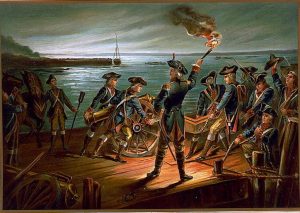 1776, In Lower New York Bay, British regiments are ferried from Staten Island to Gravesend Bay, Aug. 22. Over the next several days they outflank Washington’s forces in the Battle of Long Island, which will be largest on the continent before the Civil War. After suffering 300 killed and more than 1,000 captured, Americans are forced to retreat across East River to New York on night of Aug. 30. British Gen. William Howe seems to let them, perhaps to support an attempt to negotiate end to war.
1776, In Lower New York Bay, British regiments are ferried from Staten Island to Gravesend Bay, Aug. 22. Over the next several days they outflank Washington’s forces in the Battle of Long Island, which will be largest on the continent before the Civil War. After suffering 300 killed and more than 1,000 captured, Americans are forced to retreat across East River to New York on night of Aug. 30. British Gen. William Howe seems to let them, perhaps to support an attempt to negotiate end to war.
That fails, but Washington continues to retreat, fighting rear-guard actions at Harlem Heights, Sept. 16; Pell’s Point, Oct. 18; and White Plains, Oct. 28.
On Sept. 21, fire sweeps through much of New York, destroying 493 buildings. Each side blames the other, but Washington is not sorry it happened.
Particularly stinging is the loss of Fort Washington, at high point of northern Manhattan, with 2,800 defenders taken prisoner, Nov. 16.
British make New York their main headquarters until the end of the war, departing on Evacuation Day, Nov. 25, 1783.
1776, Cherokee-colonial wars, with off-and-on raids and skirmishes along the Carolina-North Georgia frontier. Cherokee ally with Muscogee and Shawnee groups, and with British and Loyalists against rebelling colonists. Fighting continues into 1794, long after British depart.
1776, Andrew Doria, a 14-gun brig flying the new “Grand Union” flag of the rebelling colonies, sails into Sint Eustatius anchorage to buy munitions. Dutch fire welcoming salute from Fort Oranje, Nov. 16, the first international acknowledgement of American independence.
British protest bitterly, but Americans will receive as much as half their overseas military supplies during the Revolution via the tiny free-port island.
1776, In The Wealth of Nations, Adam Smith argues that slavery does not produce economic benefits equal to that of free workingmen. Which undermines British merchants’ assumption that colonial slavery is essential to generating cheap commodities for the home country.
1776, David Hartley, representing Hull, is the first member to call upon Britain’s parliament to condemn slave trade as “contrary to the laws of God and man.” He finds few allies.
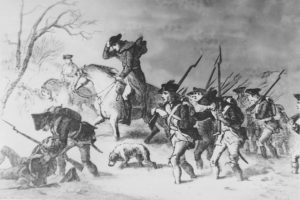 The Continental Army rushes to deliver vaccines.
The Continental Army rushes to deliver vaccines.
1777, With smallpox moving through Philadelphia and other cities, Washington orders variolation inoculation, Feb. 6, of entire Continental army at Morristown, NJ, and of all new formations coming north through Philadelphia. Variolation requires that scrappings from pustules of an infected person be transferred into open scratches of receptees.
Smallpox comes and goes throughout the war, killing perhaps 130,000 people altogether, with Indians and slaves particularly hard hit. Washington himself bears facial scars of smallpox, contracted when visiting Barbados as a teenager.
1777, Americans stop British army descending into New York from Canada at Battles of Bennington and Saratoga. British Gen. Burgoyne surrenders his army Oct. 17.
Constitution of newly independent Vermont bans slavery.
1777, Morocco’s Sultan Muhammad III includes U.S. on a list of nations to which Moroccan ports are open. Morocco is thus the first country to publicly recognize independent U.S.
1778, Virginia General Assembly votes to ban importation of slaves by sea or land, Oct. 27.
1778, Slavery made illegal in Scotland, by order of an Edinburgh court. All slaves in Scotland, perhaps 80, are now free.
But Scots continue to hold 30 percent of all Jamaica plantations and slaves.
1778, France, encouraged by American success at Saratoga, recognizes independent U.S. and signs Treaty of Alliance, Feb. 6. Britain declares war on France. Spain joins conflict as an ally of France, June 1779.
Spain’s forces will clear Mississippi of British and take their bases at Mobile Bay, 1780, and Pensacola, 1781.
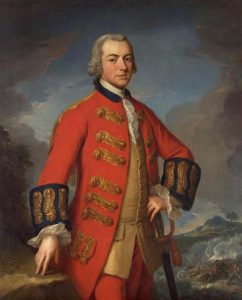 British General Henry Clinton.
British General Henry Clinton.
1779, British Gen. Henry Clinton issues Philipsburg Proclamation, offering freedom to any Negro who deserts his rebel master and the chance to follow any occupation “he shall think proper,” June 30 at his headquarters in the Philipsburg Manor House north of Tarrytown, NY.
Extends the Dunmore Proclamation of 1775 and does not require slaves to fight for the crown. Thousands of slaves do run for British lines, including 5,000 in Georgia alone.
1779, In England, Samuel Crompton invents spinning mule, a hybrid of the spinning jenny and the water frame, further accelerating demand for cotton.
1779, American force under Gen. John Sullivan destroys more than 40 villages and their winter stores to drive Mohawk, Cayuga, Onondaga and Seneca people from central and western New York, September.
Scorched-earth attack is in retaliation for 1778 Loyalist and Indian attacks on Pennsylvania’s Wyoming Valley (300 of 375 Americans killed), and New York’s Germann Flatts and Cherry Valley (48 killed and 80 taken captive). Thayendanegea (John Brant) is a Mohawk leader.
More than 5,000 Iroquois flee to British-held Fort Niagara; many more succumb to famine and exposure.
Few Iroquois return after the war, including few Oneida and Tuscorara who had largely sided with Americans. Land is “secured” by U.S. in Treaty of Fort Stanwix, October 1784. White settlers move in, largely from New England.
